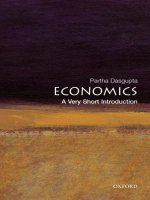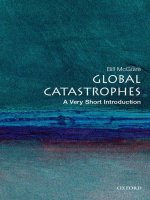Global Warming: A Very Short Introduction
Bạn đang xem bản rút gọn của tài liệu. Xem và tải ngay bản đầy đủ của tài liệu tại đây (3.75 MB, 177 trang )
Global Warming: A Very Short Introduction
Very Short Introductions are for anyone wanting a stimulating
and accessible way in to a new subject. They are written by experts, and have
been published in more than 25 languages worldwide.
The series began in 1995, and now represents a wide variety of topics
in history, philosophy, religion, science, and the humanities. Over the next
few years it will grow to a library of around 200 volumes – a Very Short
Introduction to everything from ancient Egypt and Indian philosophy to
conceptual art and cosmology.
Very Short Introductions available now:
ANARCHISM Colin Ward
ANCIENT EGYPT Ian Shaw
ANCIENT PHILOSOPHY
Julia Annas
ANCIENT WARFARE
Harry Sidebottom
THE ANGLO-SAXON AGE
John Blair
ANIMAL RIGHTS
David DeGrazia
ARCHAEOLOGY Paul Bahn
ARCHITECTURE
Andrew Ballantyne
ARISTOTLE Jonathan Barnes
ART HISTORY Dana Arnold
ART THEORY Cynthia Freeland
THE HISTORY OF
ASTRONOMY Michael Hoskin
Atheism Julian Baggini
Augustine Henry Chadwick
BARTHES Jonathan Culler
THE BIBLE John Riches
BRITISH POLITICS
Anthony Wright
Buddha Michael Carrithers
BUDDHISM Damien Keown
CAPITALISM James Fulcher
THE CELTS Barry Cunliffe
CHOICE THEORY
Michael Allingham
CHRISTIAN ART Beth Williamson
CHRISTIANITY Linda Woodhead
CLASSICS Mary Beard and
John Henderson
CLAUSEWITZ Michael Howard
THE COLD WAR Robert McMahon
Continental Philosophy
Simon Critchley
COSMOLOGY Peter Coles
CRYPTOGRAPHY
Fred Piper and Sean Murphy
DADA AND SURREALISM
David Hopkins
Darwin Jonathan Howard
Democracy Bernard Crick
DESCARTES Tom Sorell
DRUGS Leslie Iversen
THE EARTH Martin Redfern
EGYPTIAN MYTH Geraldine Pinch
EIGHTEENTH-CENTURY
BRITAIN Paul Langford
EMOTION Dylan Evans
EMPIRE Stephen Howe
ENGELS Terrell Carver
Ethics Simon Blackburn
The European Union
John Pinder
EVOLUTION
Brian and Deborah Charlesworth
FASCISM Kevin Passmore
THE FRENCH REVOLUTION
William Doyle
FREE WILL Thomas Pink
Freud Anthony Storr
Galileo Stillman Drake
Gandhi Bhikhu Parekh
GLOBALIZATION Manfred Steger
GLOBAL WARMING Mark Maslin
HEGEL Peter Singer
HEIDEGGER Michael Inwood
HIEROGLYPHS Penelope Wilson
HINDUISM Kim Knott
HISTORY John H. Arnold
HOBBES Richard Tuck
HUME A. J. Ayer
IDEOLOGY Michael Freeden
Indian Philosophy
Sue Hamilton
Intelligence Ian J. Deary
ISLAM Malise Ruthven
JUDAISM Norman Solomon
Jung Anthony Stevens
KAFKA Ritchie Robertson
KANT Roger Scruton
KIERKEGAARD Patrick Gardiner
THE KORAN Michael Cook
LINGUISTICS Peter Matthews
LITERARY THEORY
Jonathan Culler
LOCKE John Dunn
LOGIC Graham Priest
MACHIAVELLI Quentin Skinner
MARX Peter Singer
MATHEMATICS
Timothy Gowers
MEDICAL ETHICS Tony Hope
MEDIEVAL BRITAIN
John Gillingham and Ralph A. Griffiths
MODERN IRELAND Senia Pasˇe t a
MOLECULES Philip Ball
MUSIC Nicholas Cook
Myth Robert A. Segal
NIETZSCHE Michael Tanner
NINETEENTH-CENTURY
BRITAIN Christopher Harvie and
H. C. G. Matthew
NORTHERN IRELAND
Marc Mulholland
PARTICLE PHYSICS Frank Close
paul E. P. Sanders
Philosophy Edward Craig
PHILOSOPHY OF SCIENCE
Samir Okasha
PLATO Julia Annas
POLITICS Kenneth Minogue
POLITICAL PHILOSOPHY
David Miller
POSTCOLONIALISM
Robert Young
POSTMODERNISM
Christopher Butler
POSTSTRUCTURALISM
Catherine Belsey
PREHISTORY Chris Gosden
PRESOCRATIC PHILOSOPHY
Catherine Osborne
Psychology Gillian Butler and
Freda McManus
QUANTUM THEORY
John Polkinghorne
ROMAN BRITAIN
Peter Salway
ROUSSEAU Robert Wokler
RUSSELL A. C. Grayling
RUSSIAN LITERATURE
Catriona Kelly
THE RUSSIAN REVOLUTION
S. A. Smith
SCHIZOPHRENIA
Chris Frith and Eve Johnstone
SCHOPENHAUER
Christopher Janaway
SHAKESPEARE
Germaine Greer
SOCIAL AND CULTURAL
ANTHROPOLOGY
John Monaghan and Peter Just
SOCIOLOGY Steve Bruce
Socrates C. C. W. Taylor
SPINOZA Roger Scruton
STUART BRITAIN John Morrill
TERRORISM Charles Townshend
THEOLOGY David F. Ford
THE TUDORS John Guy
TWENTIETH-CENTURY
BRITAIN Kenneth O. Morgan
Wittgenstein A. C. Grayling
WORLD MUSIC Philip Bohlman
Available soon:
AFRICAN HISTORY
John Parker and Richard Rathbone
THE BRAIN Michael O’Shea
BUDDHIST ETHICS
Damien Keown
CHAOS Leonard Smith
CITIZENSHIP Richard Bellamy
CLASSICAL ARCHITECTURE
Robert Tavernor
CLONING Arlene Judith Klotzko
CONSCIOUSNESS Sue Blackmore
CONTEMPORARY ART
Julian Stallabrass
THE CRUSADES
Christopher Tyerman
Derrida Simon Glendinning
DESIGN John Heskett
Dinosaurs David Norman
DREAMING J. Allan Hobson
ECONOMICS Partha Dasgupta
THE ELEMENTS Philip Ball
THE END OF THE WORLD
Bill McGuire
EXISTENTIALISM Thomas Flynn
FEMINISM Margaret Walters
THE FIRST WORLD WAR
Michael Howard
FOUCAULT Garry Gutting
FUNDAMENTALISM
Malise Ruthven
Habermas Gordon Finlayson
HIROSHIMA
B. R. Tomlinson
HUMAN EVOLUTION
Bernard Wood
INTERNATIONAL RELATIONS
Paul Wilkinson
JAZZ Brian Morton
MANDELA Tom Lodge
THE MIND Martin Davies
MODERN ART David Cottington
NATIONALISM Steven Grosby
PERCEPTION Richard Gregory
PHILOSOPHY OF RELIGION
Jack Copeland and Diane Proudfoot
PHOTOGRAPHY Steve Edwards
THE RAJ Denis Judd
THE RENAISSANCE
Jerry Brotton
RENAISSANCE ART
Geraldine Johnson
ROMAN EMPIRE
Christopher Kelly
SARTRE Christina Howells
THE SPANISH CIVIL WAR
Helen Graham
TIME Leofranc Holford-Strevens
TRAGEDY Adrian Poole
THE TWENTIETH CENTURY
Martin Conway
For more information visit our web site
www.oup.co.uk/vsi
Mark Maslin
GLOBAL
WARMING
A Very Short Introduction
1
3
Great Clarendon Street, Oxford ox2 6dp
Oxford University Press is a department of the University of Oxford.
It furthers the University’s objective of excellence in research, scholarship,
and education by publishing worldwide in
Oxford New York
Auckland Bangkok Buenos Aires Cape Town Chennai
Dar es Salaam Delhi Hong Kong Istanbul Karachi Kolkata
Kuala Lumpur Madrid Melbourne Mexico City Mumbai Nairobi
São Paulo Shanghai Taipei Tokyo Toronto
Oxford is a registered trade mark of Oxford University Press
in the UK and in certain other countries
Published in the United States
by Oxford University Press Inc., New York
© Mark Maslin 2004
The moral rights of the author have been asserted
Database right Oxford University Press (maker)
First published as a Very Short Introduction 2004
All rights reserved. No part of this publication may be reproduced,
stored in a retrieval system, or transmitted, in any form or by any means,
without the prior permission in writing of Oxford University Press,
or as expressly permitted by law, or under terms agreed with the appropriate
reprographics rights organizations. Enquiries concerning reproduction
outside the scope of the above should be sent to the Rights Department,
Oxford University Press, at the address above
You must not circulate this book in any other binding or cover
and you must impose this same condition on any acquirer
British Library Cataloguing in Publication Data
Data available
Library of Congress Cataloging in Publication Data
Data available
ISBN 0–19–284097–5
13579108642
Typeset by RefineCatch Ltd, Bungay, Suffolk
Printed in Great Britain by
TJ International Ltd., Padstow, Cornwall
Contents
Acknowledgements ix
Abbreviations xi
List of illustrations xiii
Introduction 1
1 What is global warming? 4
2 A brief history of the global warming hypothesis 23
3 Your viewpoint determines the future 36
4 What is the evidence for climate change? 43
5 How do you model the future? 67
6 What are the possible future impacts of global
warming?
83
7 Surprises 102
8 Politics 118
9 What are the alternatives? 134
10 Conclusion 146
Further reading 151
Index 153
This page intentionally left blank
Acknowledgements
The author would like to thank the following people: Johanna and
Alexandra Maslin for being there; Emma Simmons and Marsha Filion
for their excellent editing and skill of finally extracting the book
from me; Catherine D’Alton and Elanor McBay of the Department of
Geography Drawing Office UCL; John Adams for helping me develop
my critical view of this debate; Richard Betts and Eric Wolff for their
insightful and extremely helpful reviews; and all my colleagues in
climatology, palaeoclimatology, social science, and economics who
continue to strive to understand and predict our influence on climate.
This page intentionally left blank
Abbreviations
AABW Antarctic Bottom Water
AO Arctic Oscillation
AOGCM Atmosphere–Ocean General Circulation Models
AOSIS Alliance of Small Island States
BINGO Business and Industry Non-Governmental Organization
CFCs chlorofluorocarbons
COP Conference of the Parties
ENGO Environmental Non-Governmental Organization
ENSO El Nin
~
o-Southern Oscillation
GCM general circulation model
GCR galactic cosmic ray
GHCM Global Historical Climate Network
IPCC Intergovernmental Panel on Climate Change
JUSSCANNZ Japan, USA, Switzerland, Canada, Australia,
Norway and New Zealand
MAT marine air temperature
NADW North Atlantic deep water
NAO North Atlantic Oscillation
NGO Non-Governmental Organization
NRC National Research Council
OECD Organization for Economic Cooperation and Development
OPEC Organization of Petroleum Exporting Countries
ppbv parts per billion by volume
ppmv parts per million by volume
SST sea-surface temperature
THC Thermohaline Circulation
UNCTAD United Nations Conference on Trade and
Development
UNFCCC United Nations Framework Convention on Climate
Change
VBD vector-borne disease
List of illustrations
1 The earth’s annual
global mean energy
balance 5
2 Greenhouse gases and
temperature for the last
four glacial cycles
recorded in the Vostok ice
core 7
3 Indicators of the human
influence on the
atmosphere composition
during the industrial
era 9
4a CO
2
emissions from
industrial processes 12
4b CO
2
emissions from
land-use change 12
5 Possible climate system
responses to a
linear-forcing 18
6 Variation of the earth’s
surface temperature 30
7 Global warming
and the media 32
8 The four myths of
nature 37
9 Four myths of human
nature 39
10 Four rationalities 40
11 Combined global
warming scenarios
with myths of human
nature 41
12 The anatomy of past
climatic changes 44
13 Northern Hemisphere
temperature
reconstruction for the
last thousand years 47
14 Global distribution
of meteorological
stations 50
15 Changes in precipitation
over land 54
16 Estimated sea-level
rise 1910–1990 56
17 Mozambique floods
of 2000 59
18 Ice core records showing
CO
2
in phase with
Antarctic warming 61
19 Simulated annual
global mean surface
temperatures 63
20 Schematic of observed
variations of the
a) temperature indicators
and b) hydrological and
storm-related
indicators 64
21 Locations at which
systematic long-term
studies meet stringent
criteria documenting
recent climate change
impacts on physical
and biological systems 66
22 The development of
climate models, past,
present, and future 69
23 A simplified version of
the present carbon
cycle 72
24 Global, annual-mean
radiative forcings 74
25 The global climate
of the 21st century 76
26 Flooding of Bangladesh
in 1998 86
27 El Nin
~
o – Southern
Oscillation 92
28 The deep circulation
of the ocean 106
29 Different possible
circulation of the
deep ocean 108
30 Future sea level
changes 110
31 Bifurcation of the
climate system 111
32 Met office model of CO
2
concentration and mean
temperature over time 115
33 Five different cost
scenarios 129
34 Climate change risks
with increasing global
temperatures 135
Introduction
Global warming is one of the most controversial science issues of
the 21st century, challenging the very structure of our global society.
The problem is that global warming is not just a scientific concern,
but encompasses economics, sociology, geopolitics, local politics,
and individuals’ choice of lifestyle. Global warming is caused by the
massive increase of greenhouse gases, such as carbon dioxide, in
the atmosphere, resulting from the burning of fossil fuels and
deforestation. There is clear evidence that we have already elevated
concentrations of atmospheric carbon dioxide to their highest level
for the last half million years and maybe even longer. Scientists
believe that this is causing the Earth to warm faster than at any
other time during, at the very least, the past one thousand years.
The most recent report by the Intergovernmental Panel on Climate
Change (IPCC), amounting to 2,600 pages of detailed review and
analysis of published research, declares that the scientific
uncertainties of global warming are essentially resolved. This report
states that there is clear evidence for a 0.6°C rise in global
temperatures and 20 cm rise in sea level during the 20th century.
The IPCC synthesis also predicts that global temperatures could
rise by between 1.4°C and 5.8°C and sea level could rise by between
20 cm and 88 cm by the year 2100. In addition, weather patterns
will become less predictable and the occurrence of extreme climate
events, such as storms, floods, and droughts, will increase.
This book tries to unpick the controversies that surround the global
warming hypothesis and hopefully provides an incentive to read
1
more on the subject. It starts with an explanation of global warming
and climate change and is followed by a review of how the global
warming hypothesis was developed. The book will also investigate
why people have such extreme views about global warming, views
which reflect both how people view nature and their own political
agenda.
The second half of the book examines the evidence showing that
global warming has already occurred and the science of predicting
climate change in the future. The potentially devastating effects of
global warming on human society are examined, including drastic
changes in health, agriculture, the economy, water resources,
coastal regions, storms and other extreme climate events, and
biodiversity. For each of these areas scientists and social scientists
have made estimates of the potential direct impacts; for example, it
is predicted that by 2025 five billion people will experience water
stress. The most important impacts are discussed in this book,
along with plans to mitigate the worst of them.
There are also potential surprises that the global climate system
might have in store for us, exacerbating future climate change.
These include the very real possibility that global deep-ocean
circulation could alter, plunging Europe into a succession of
extremely cold winters or causing unprecedented global rise in sea
level. There are predictions that global warming may cause vast
areas of the Amazon rainforest to burn, adding extra carbon to
the atmosphere and thus accelerating global warming. Finally,
there is a deadly threat lurking underneath the oceans: huge
reserves of methane which could be released if the oceans warm up
sufficiently – again accelerating global warming. The final chapters
look at global politics and potential adaptations to global warming.
It should be realized that the cost of significantly cutting fossil-fuel
emissions may be too expensive in the short term and hence the
global economy will have to become more flexible and thus adapt to
climate change. We will also have to prioritize which parts of our
global environment to protect. The theory of global warming thus
2
Global Warming
challenges our current concepts of the nation-state versus global
responsibility, and the short-term vision of our political leaders,
both of which must be overcome if global warming is to be
dealt with effectively. Be under no illusion: if global warming
is not taken seriously, it will be the poorest people in our global
community, as usual, that suffer most.
3
Introduction
Chapter 1
What is global warming?
The Earth’s natural greenhouse
The temperature of the Earth is controlled by the balance between
the input from energy of the sun and the loss of this back into space.
Certain atmospheric gases are critical to this temperature balance
and are known as greenhouse gases. The energy received from
the sun is in the form of short-wave radiation, i.e. in the visible
spectrum and ultraviolet radiation. On average, about one-third of
this solar radiation that hits the Earth is reflected back to space.
Of the remainder, some is absorbed by the atmosphere, but most
is absorbed by the land and oceans. The Earth’s surface becomes
warm and as a result emits long-wave ‘infrared’ radiation. The
greenhouse gases trap and re-emit some of this long-wave
radiation, and warm the atmosphere. Naturally occurring
greenhouse gases include water vapour, carbon dioxide, ozone,
methane, and nitrous oxide, and together they create a natural
greenhouse or blanket effect, warming the Earth by 35°C. Despite
the greenhouse gases often being depicted in diagrams as one layer,
this is only to demonstrate their ‘blanket effect’, as they are in fact
mixed throughout the atmosphere (see Figure 1).
Another way to understand the Earth’s natural ‘greenhouse’ is by
comparing it to its two nearest neighbours. A planet’s climate is
decided by several factors: its mass, its distance from the sun, and of
course the composition of its atmosphere and in particular the
4
1. The Earth’s annual global mean energy balance
amount of greenhouse gases. For example, the planet Mars is very
small, and therefore its gravity is too small to retain a dense
atmosphere; its atmosphere is about a hundred times thinner
than Earth’s and consists mainly of carbon dioxide. Mars’s average
surface temperature is about −50°C, so what little carbon dioxide
exists is frozen in the ground. In comparison, Venus has almost the
same mass as the Earth but a much denser atmosphere, which is
composed of 96% carbon dioxide. This high percentage of carbon
dioxide produces intense global warming and so Venus has a
surface temperature of over + 460°C.
The Earth’s atmosphere is composed of 78% nitrogen, 21% oxygen,
and 1% other gases. It is these other gases that we are interested
in, as they include the so-called greenhouse gases. The two most
important greenhouse gases are carbon dioxide and water vapour.
Currently, carbon dioxide accounts for just 0.03–0.04% of the
atmosphere, while water vapour varies from 0 to 2%. Without the
natural greenhouse effect that these two gases produce, the Earth’s
average temperature would be roughly −20°C. The comparison
with the climates on Mars and Venus is very stark because of the
different thicknesses of their atmospheres and the relative amounts
of greenhouse gases. However, because the amount of carbon
dioxide and water vapour can vary on Earth, we know that this
natural greenhouse effect has produced a climate system which is
naturally unstable and rather unpredictable in comparison to those
of Mars and Venus.
Past climate and the role of carbon dioxide
One of the ways in which we know that atmospheric carbon dioxide
is important in controlling global climate is through the study of
our past climate. Over the last two and half million years the Earth’s
climate has cycled between the great ice ages, with ice sheets over 3
km thick over North America and Europe, to conditions that were
even milder than they are today. These changes are extremely rapid
if compared to other geological variations, such as the movement of
6
Global Warming
continents around the globe, where we are looking at a time period
of millions of years. But how do we know about these massive ice
ages and the role of carbon dioxide? The evidence mainly comes
from ice cores drilled in both Antarctica and Greenland. As snow
falls, it is light and fluffy and contains a lot of air. When this is
slowly compacted to form ice, some of this air is trapped. By
extracting these air bubbles trapped in the ancient ice, scientists can
measure the percentage of greenhouse gases that were present in
the past atmosphere. Scientists have drilled over two miles down
into both the Greenland and Antarctic ice sheets, which has enabled
them to reconstruct the amount of greenhouse gases that occurred
in the atmosphere over the last half a million years. By examining
the oxygen and hydrogen isotopes in the ice core, it is possible to
estimate the temperature at which the ice was formed. The results
are striking, as greenhouse gases such as atmospheric carbon
dioxide (CO
2
) and methane (CH
4
) co-vary with temperatures over
the last 400,000 years (see Figure 2). This strongly supports the
2. Greenhouse gases and temperature for the last four glacial cycles
recorded in the Vostok ice core
7
What is global warming?
idea that the carbon dioxide content in the atmosphere and global
temperature are closely linked, i.e. when CO
2
and CH
4
increase, the
temperature is found to increase and vice versa. This is our greatest
concern for future climate: if levels of greenhouse gases continue to
rise, so will the temperature of our atmosphere. The study of past
climate, as we will see throughout this book, provides many clues
about what could happen in the future. One of the most worrying
results from the study of ice cores, and lake and deep-sea sediments,
is that past climate has varied regionally by at least 5°C in a few
decades, suggesting that climate follows a non-linear path. Hence
we should expect sudden and dramatic surprises when greenhouse
gas levels reach an as yet unknown trigger point in the future.
The rise in atmospheric carbon dioxide during the
industrial period
One of the few areas of the global warming debate which seems to
be universally accepted is that there is clear proof that levels of
atmospheric carbon dioxide have been rising ever since the
beginning of the industrial revolution. The first measurements of
CO
2
concentrations in the atmosphere started in 1958 at an altitude
of about 4,000 metres on the summit of Mauna Loa mountain in
Hawaii. The measurements were made here to be remote from
local sources of pollution. What they have clearly shown is that
atmospheric concentrations of CO
2
have increased every single year
since 1958. The mean concentration of approximately 316 parts
per million by volume (ppmv) in 1958 rose to approximately 369
ppmv in 1998 (see Figure 3). The annual variations in the Mauna
Loa observatory are mostly due to CO
2
uptake by growing plants.
The uptake is highest in the northern hemisphere springtime;
hence every spring there is a drop in atmospheric carbon dioxide
which unfortunately does nothing to the overall trend towards ever
higher values.
This carbon dioxide data from the Mauna Loa observatory can be
combined with the detailed work on ice cores to produce a complete
8
Global Warming
3. Indicators of the human influence on the atmosphere composition
during the industrial era
record of atmospheric carbon dioxide since the beginning of the
industrial revolution. What this shows is that atmospheric CO
2
has increased from a pre-industrial concentration of about 280
ppmv to over 370 ppmv at present, which is an increase of 160
billion tonnes, representing an overall 30% increase. To put this
increase into context, we can look at the changes between
the last ice age, when temperatures were much lower, and the
pre-industrial period. According to evidence from ice cores,
atmospheric CO
2
levels during the ice age were about 200 ppmv
compared to pre-industrial levels of 280 ppmv – an increase of
over 160 billion tonnes – almost the same CO
2
pollution that we
have put into the atmosphere over the last 100 years. This carbon
dioxide increase was accompanied by a global warming of 6°C as
the world freed itself from the grips of the last ice age. Though
the ultimate cause of the end of the last ice age was changes in
the Earth’s orbit around the sun, scientists studying past climates
have realized the central role atmospheric carbon dioxide has
as a climate feedback translating these external variations into
the waxing and waning of ice ages. It demonstrates that the
level of pollution that we have already caused in one century
is comparable to the natural variations which took thousands
of years.
The enhanced greenhouse effect
The debate surrounding the global warming hypothesis is whether
the additional greenhouse gases being added to the atmosphere will
enhance the natural greenhouse effect. Global warming sceptics
argue that though levels of carbon dioxide in the atmosphere are
rising, this will not cause global warming, as either the effects are
too small or there are other natural feedbacks which will counter
major warming. Even if one takes the view of the majority of
scientists and accepts that burning fossil fuels will cause warming,
there is a different debate over exactly how much temperatures will
increase. Then there is the discussion about whether global climate
will respond in a linear manner to the extra greenhouse gases or
10
Global Warming









